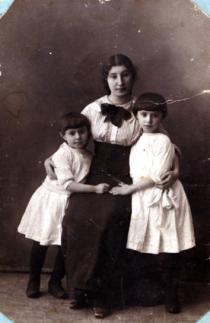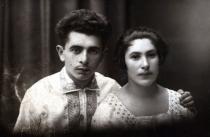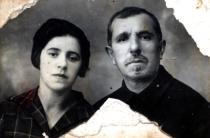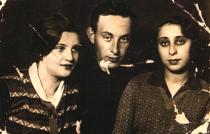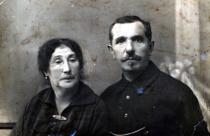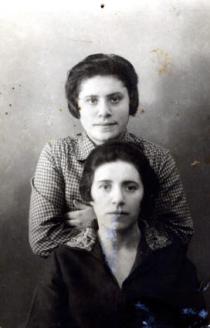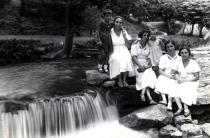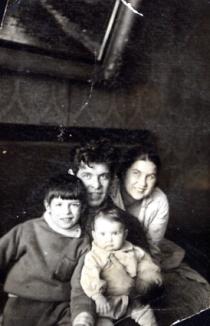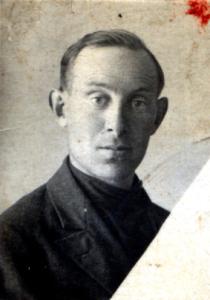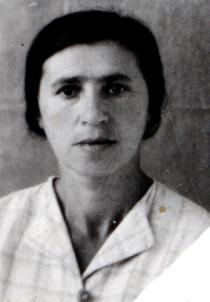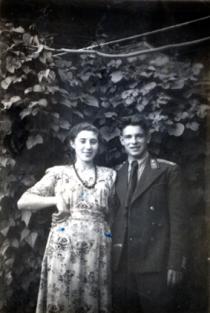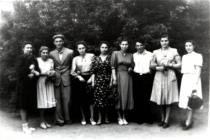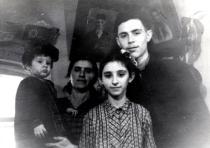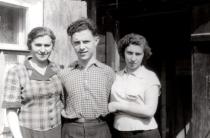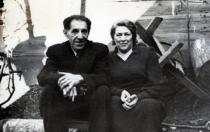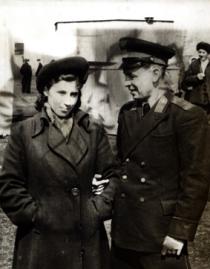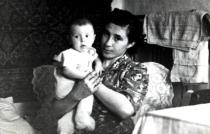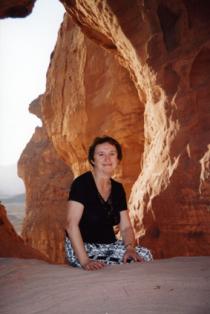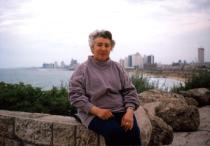
Maria Zabozlaeva
Saratov
Russia
Interviewer: Bozhena Zbaraska-Anatol
Date of interview: 30 September 2003
Maria Zabozlaeva is a very nice woman with a kind smile. She is very reserved. She was pleased to get this opportunity to tell the story of her life. She lives alone. Her children and grandchildren live separately. She wears plain clothes. Her apartment is small and she has old furniture that bought many years before. She has a small collection of books in her bookcase: there are books by Russian classics and books on medicine. Maria says that she starts her day talking to her friends and relatives on the phone: she calls it ‘phone visits’. She often talks to her brother Michael and sister Vera. They live in Israel. Her son Fyodor calls every day to ask his mother how she feels. He always brings her all she needs when she cannot leave home. We talk in a warm and cozy room. There are fruit, sweets and tea on the table. Maria enjoys talking about her family.
Saratov [over 800 km from Moscow] is a beautiful old town on the Volga, the biggest river in Russia. In the second half of 19th century it became a big industrial center of bread and flour grinding industries. There were steam mills and butteries built in the town. There were many stores and shops in the town and barges in the harbor selling cement, grain, water melons, fish and furs. There was book publishing developed in Saratov. There were straight streets lined with trees leading from the Volga uptown. They were called ascends. There were parks and squares with brass orchestras playing in the evenings in the center of the town. There were one and two-storied stone houses built in the town. In late 19th century there was Russian, German, Jewish, Tatar and Polish population in the town. Russians belonged to Old Believers 1 and Christians. There was a Catholic cathedral, a Lutheran church, a synagogue, and many orthodox Christian churches 2 that made the town different from other in Povolzhye.
The first Jews settled down in the town in early 19 century. In late 19 century there were first canonists 3 coming to the town. There was a pogrom in Saratov in 1853 inspired by authorities by the so-called ‘blood shedding slander’. There was a case of ritualistic murders that Jews were blamed of. After the pogrom Jews began to be deported to reside within the Pale of Settlement 4. The Jews that remained in the town formed a Jewish community by the end of 19th century. In 1897 they built a synagogue. They invited a rabbi from Tsaritsyn [Volgograd at present, 300 km from Saratov]. Jews owned stores and shops selling fish, flour, books, watches, gold and silver. Bender was one of the biggest merchants of his time. He had a prêt-a-porter garment store on the ground floor of his house. Another merchant Ochkin owned hotel ‘Centralnaya’ and a garden with a concert hall and restaurant. Many Jews were craftsmen. They resided in the Jewish neighborhood near the synagogue. The majority of Jews were poor. There was another pogrom in Saratov during revolutionary events in 1905. There were no Jewish educational institutions before the revolution of 1917 5 since the laws of the Russian empire didn’t allow any national educational institutions beyond the Pale of Settlement. [Editor’s note: however, Jewish communities were allowed to make contributions to existing small educational groups, but neither archives of the synagogue in Saratov nor state archives of Saratov region have any references in this regard. The state rabbi came from Tsaritsyn before 1915 and in 1915 there was a rabbi appointed in Saratov.] There was a Jewish school opened after the revolution of 1917. In 1934 Soviet authorities closed the Jewish school during the period of struggle against religion 6. Nowadays Jewish school ‘OR Avner’ functions in Saratov.
Мy paternal grandfather Semyon Ogushevich was born in Saratov, sometime in 1870s. Grandfather Semyon was a strict, morose, taciturn and severe man. There is his portrait hanging on the wall in a photograph taken in my mother’s apartment. I remember that he worked a lot, repairing primus stoves 7 and water pipes. He was tall and thin and had a gray beard and long hair. I don’t remember whether he wore a hat or a kippah. Grandfather Semyon was very religious. He celebrated all holidays and observed traditions, went to synagogue and prayed a lot. My grandfather had two or three books with yellow pages that he used when praying. I remember that he prayed at home with his tefillin on his hand and forehead. He also had a tallit on. I don’t think grandfather gave much thought to a change of regime since he was busy repairing primus stoves from morning till night. There were no discussions about the revolution in his home. He died when I was seven. I remember him lying on the floor wrapped in his tallit and there were candles burning around him. Grandfather was buried at the section for men at the Jewish cemetery in Saratov according to Jewish traditions in 1936.
My grandmother Vera Ogushevich, whose maiden name I don’t know, was born in Saratov in 1870s. My grandfather never talked about her and I have very little information. She was religious and went to synagogue. She wore long skirts. I only saw her portrait, a big one where she had a black shawl on her head. She was a housewife and spoke Yiddish. My grandparents didn’t give any Jewish education to their children. Grandmother Vera died in Saratov in 1929. She was buried at the section for women at the Jewish cemetery in Saratov.
My grandmother and grandfather had five children: three sons – my father Esaih Ogushevich and Osip and Michael Avgustevich, and two daughters – Sophia Ogushevich and Raisa Riabskaya, nee Ogushevich. When I grew up my father told me why his brothers had a different last name. When World War I began their father decided to save his sons from the army. My grandfather managed somehow to give his sons different surnames. According to laws of Russian empire one son of old parents did not serve in army. Therefore my father Esaih is Ogushevich and his brother Michael is Avgustevich. To tell the truth my grandfather has with surnames in family a muddle. Someone has incorrectly written down surnames of children of great-grandfather Efima, therefore my grandfather Semyon and his brother Ilya - Ogushevich, and brothers Osip, Moisey, Lev and sister Sima – Avgushevich.
Osip Avgustevich was born in Saratov in 1894. Grandfather taught Osip his profession and he became a plumber. His wife Dvosia – I don’t know her maiden name, was a Jew. She was a housewife. They were moderately religious, but they didn’t raise their children religious. This is all I know about them. They died and were buried at the Jewish cemetery in Saratov. They had three sons: their older son Moisey, I don’t know his date of birth. He perished at the front during the Great Patriotic War 8 in 1942. Their middle son Ilia was born in 1933. In August 1945 he married Bertha Yudovich, a Jewish girl. They had a traditional wedding with a chuppah at the synagogue. I went to the wedding and this was the first traditional Jewish wedding that I attended. There was a big hall on the second floor of their house. There was a tent on four posts and on top of it there was a canopy of а beautiful gold glittering fabric. There were 10-15 guests at the wedding party. They were relatives, there were no other guests. Ilia wore a dark suit. Bertha had a beautiful pinkish dress of average length, bright, with flounces, elbow-long sleeves, covered shoulders. She had her long hair done and adorned. She wore white shoes and white socks. The ride and bridegroom stood under the chuppah. The rabbi spoke Yiddish, but I don’t know what it was about. We were standing around. When he finished his recitation somebody gave the bride and bridegroom glasses with red wine and they sipped it. I remember this. I don’t remember what kind of food there was on the tables since I was overwhelmed with the occasion.
Ilia finished Pedagogical College in Saratov and went to work in Belgorod [approximately 600 km from Moscow] where he lectured at the Pedagogical College. He is candidate of philological sciences and a pensioner. He lives in Belgorod. Ilia’s daughter Elena Elkonina lived with her husband Lev Elkonin, Jew, in Saratov. She died in 1998 and was buried at the Jewish cemetery in Saratov. There were all rules followed, there was a minyan gathering and they recited Kaddish. I was present there and saw ten men wearing kippot reading the Kaddish. There was Rafail Yablonski among them, cousin brother of deceased Elena Elkonina. Since he didn’t have a kippah he wore a kerchief tied in knots.
Younger son Semyon was born in Saratov in 1938. After finishing a secondary school he finished Biological faculty of the State University in Saratov. He is candidate of psychological sciences, lives in Moscow and works in the Joint 9. We often talk on the phone. When Semyon comes to Saratov on business he comes to see me.
His brother Michael Avgustevich was born in Saratov in 1896. He was a plumber like his brothers. He died in 1972. His wife Chasia, nee Sverdlova, a Jew, was born in Saratov in 1900. She was housewife. She died in 1997. They were both buried at the Jewish cemetery in Saratov. Their daughter Elia Yablonskaya was born in Saratov in 1925. She finished an obstetrician school in Saratov and worked as an obstetrician medical assistant in maternity hospital #2. Her husband Shmul Yablonski was a Jew. All I know about him is that he died and was buried at the Jewish cemetery in Saratov. Elia died in 2003 and was buried at the Jewish cemetery according to the Jewish tradition. There was a minyan gathering and a Kaddish recited. Elia and Shmul had a son, born in Saratov in 1952. His name was Rafail Yablonski. He finished the Faculty of Electronics at Saratov Polytechnic College. After finishing the college he worked at the Tantal, a company belonging to an electronic industry. Now he is director of Grade-Star Ltd. Company dealing in rewinding of electric engines. We keep in touch.
One of my grandparent’s daughter Sophia Ogushevich was born in Saratov some time in 1900s. I don’t know what kind of education she got. All I know is that she was good at accounting. At the age of 20 or so she moved to Moscow. She was single and lived with her sister Raisa in Moscow. Sophia had a hard life. She worked as a janitor in various companies. She died in Moscow. Regretfully, this is all I know about Sophia.
Her sister Raisa Riabskaya, nee Ogushevich was born in 1890s. After getting married she moved to Moscow and became a housewife. Her husband Chaim Raibski was a Jew. He was a food supplier. Their daughter Chasia was born in early 1920s. She lives in Moscow. She worked as an economist. Now she is a pensioner. Raisa’s second daughter Minna was born in the middle of 1920s. She lived in Moscow and worked in a design office. She died in Moscow in 1991. Raisa’s son Emil was born in Moscow in late 1920s. During the Great Patriotic War he was at the front. He was shell-shocked and had to wear and hearing device for the rest of his life. Emil’s wife Tamara Kluchareva is 80 years old. Their daughter’s name is Marina Riabskaya. We keep in touch with them and my sister Vera Belova lived in their home all five years of her studies.
Both sisters, Sophia and Raisa were moderately religious while Minna’s daughter Yana Khmelnitskaya is deeply religious. She celebrates all holidays, prays a lot, often goes to a synagogue in Moscow and follows kashrut. She is a real Jew. I don’t know how she came to be so religious. Yana’s son Ivan Khmelnitski studies in the 11th form in a Jewish school in Moscow and is also deeply religious.
My father Esaih Ogushevich was born in Saratov in 1904. After the revolution of 1917 he finished a Russian lower secondary school, Construction College and worked as a plumber. My father worked long hours. He took after grandfather Semyon: taciturn, strict and hardworking. He wore a tunic, but no hat. He only put on a kippah and tallit at the synagogue and tefillin on his hand and forehead when praying. He went to the synagogue with his father and his brother Michael. We lived in neighboring houses with them. And at Friday and at Saturday evening we waited at the gate of our home when they returned from synagogue.
My maternal grandfather Abram Buch was born in Saratov in 1870s. My grandfather was strict and vicious. I would even call him despotic. He seemed to be unapproachable, but he really did love us. He was a tailor: he made women’s clothes. Grandfather Abram was a big handsome man with gray streaks in his hair. He always dressed like a dandy and wore a tolstovka 10 where he had a watch in a small pocket with a thick golden chain hanging on his chest. He lived with grandmother Sophia and their children in a two-storied house in Cheluskintsy Street on the corner of Volskaya Street. At that time it was far from the center of the town. There was a house where actors of the drama theater resided. This house is still there. There were communal apartments 11 in this house. My grandparents lived in one room where they had a bed, a wardrobe, an armchair and big table. There was a big sewing machine that was used to sew leather and thick woolen fabrics and a mannequin. In the kitchen they had a table, a kerosene stove and shelves for crockery. They had neighbors residing on the first floor – a Russian Christian family of the Victorovs and a Jewish family on the second floor. The name of the head of the family was Iosif Rys. He happened to be my future mother-in-law’s brother. My grandparents got along with their neighbors very well.
I visited my grandmother at Chanukkah with a little bag on my chest where I put Chanukkah gelt that they gave me. Even now I give Chanukkah gelt to my grandchildren, even though I do not celebrate these holidays. I give them money in the memory of my grandmother and grandfather. I don’t think grandfather Abram was not enthusiastic about the revolution of 1917 since the new regime expropriated his property 12. He was a tailor and owned a shop, as I imagine. His daughters also specialized in tailoring: Rosa made hats and my mother made dresses and suits. The family was moderately religious. I know little about them since we lived separately, but I remember that they fasted at Yom Kippur. They drank coffee with challah bread the night before and didn’t have any food until the men returned from the synagogue when the first star appeared in the sky on the following day. Grandfather Abram died in 1942 and was buried at the men’s section of the Jewish cemetery in Saratov. I don’t know whether he was buried in accordance with the Jewish tradition.
My maternal grandmother Sophia Buch whose maiden name I don’t remember was born in Saratov in 1870s. She was a housewife that was customary with Jewish women. My grandmother was short, thin, nice and quiet. I would call her timid. She always obeyed and listened to grandfather. She didn’t wear a wig and only wore a kerchief occasionally. She wore her hair in a knot on the back. My mother never told me whether she got any religious education. My grandparents’ daughters Vera, Anna and Rosa were not religious while my mother and her sister Anelia were moderately religious. Grandmother Sophia died in April 1941, one month before my sister Vera was born.
My grandparents had seven children. They were born in Saratov. I don’t know their dates of birth.
The older daughter Anelia finished a grammar school in Saratov, got married and moved to Kuibyshev [present Samara, over 800 km from Moscow]. Her husband was Russian, his name was Alexei Latyshov. He was director of a military plant in Kuibyshev. I don’t know what Anelia was doing. Their son Evgeni Latyshov, born in 1936, finished the Polytechnic College in Samara. He worked as an engineer. Aunt Anelia died in Saratov.
The next daughter was Rosa. Her husband Alexei Kanailov was Russian too. He was a Party official and worked as secretary of the regional Party committee. They lived in Leningrad [over 400 km from Moscow] before the war. In 1942 they evacuated to Saratov and lived with us. After the war they moved to Kaliningrad [900 km from Moscow]. They had four children. Their old daughter Ninel had a philological education. She worked as a librarian. She lives in Kaliningrad. Sophia, born in 1941, before the war I believe, lives in Tartu [today Estonia]. She worked as a teacher of mathematic at school. Now she is a pensioner. Sergei, born in 1936, lives in St. Petersburg. He finished the Polytechnic College in Kaliningrad and worked as chief construction engineer in Siberia for many years. Now he is consultant for the Union of entrepreneurs. There was another son named Valeri. He died in a car accident.
Their next daughter Katia lived in a village near Leningrad. She was a pharmacist and worked in a pharmacy. She was single. In 1943 Germans executed Katia as a Jew.
Vera was born in 1902. I don’t know where she studied, but at the age of 13 she began to do errands for Bolshevik Antonov-Ovseyenko and then she terminated any contacts with her family since they didn’t share her revolutionary ideas. Her relatives called her Verka the machine gunner. During the Civil War 13 Vera served in the Chapaev 14 division. She married commissar of this division, a Jewish man. His name was Abram Ertman. He perished in 1919. Vera moved to Odessa and finished the College of Public Economy. She returned to Saratov and worked as an economist in the regional planning department. She met her second man Moisey Brodski in Saratov in 1924. He finished a rabfak 15 and worked as an accountant in a bank office. They didn’t get married, but lived together. Their children have their father’s last name of Brodski and Vera kept her nee name of Ertman. Vera died in 1980. She was buried at the Jewish cemetery in Saratov. Moisey Brodski was buried at the Russian Voskresenskoye cemetery in Saratov. They had three daughters. Their older daughter Dina was born in 1925. She finished the Medical College in Saratov. She became a candidate of medical sciences and worked as an assistant at the department of hygiene. Her husband Alexandr Kosmodemianski was a mathematician and correspondent member of the Academy of Sciences. They lived in Donetsk [over 900 km from Moscow] in Ukraine. Dina died in 2003. Dina’s daughter Irina was born in 1947. She and her Russian husband Vladimir Bolgrabski finished the Faculty of Mathematic of the Saratov State University. Irina is a doctor of mathematic, professor and correspondent member of the Ukrainian Academy of Sciences. Vladimir works in a computer center. Their son Igor Bolgrabski finished the Technological College in Leningrad. He works in a company and lives in Donetsk with his parents.
Nelia, their middle daughter, was born in 1932. She finished the Faculty of Geography of the Saratov State University and worked as a teacher. She is a pensioner and lives in Saratov.
Ludmila, the younger daughter, was born in 1935. Her husband Valeri Trushkov, Russian, finished the Law College in Saratov and worked in law enforcement institutions in Saratov. Ludmila finished the College of Economics in Saratov. She got the profession of economist. In 1977 her husband got a job offer from Turkmenia. They moved and lived in Ashkhabad [almost 2500 km from Moscow]. About five years ago they returned to Saratov with their younger daughter Larisa and her family. Their older daughter Irina, born in 1967, finished the Law College in Saratov in 1989. Her husband Sergei Khlebnikov, born in 1962, Russian, finished the Polygraphist College in Moscow in 1984. They met in Ashkhabad where Sergei’s parents lived. They got married and settled down in Saratov. Thy lived with Irina’s aunt Nelia Brodskaya. Irina stayed with her when studying in college. They are in business now. Irina and Sergei have two daughters: Zhenia, born in 1988, and Dasha, born in 1989. They study in the Jewish school ‘Or Avner’ in Saratov. Their younger daughter Larisa, born in 1975, finished the Faculty of Therapeutic Physical Training at the Ashkhabad College of Physical Training in 1996. Her husband Akhmed Kranov, born in 1969, Kazakh, finished Medical College in Ashkhabad in 1992. Larisa is a housewife. Their son Timur was born in 2003. Her husband Akhmed is an anesthesiologist in maternity hospital #2 in Saratov. They all keep in touch.
My mother’s brother Boris was born in 1902. During the Civil War he was in the Chapaev division. I don’t know what kind of education he had. Boris worked as an accountant in the regional department of pharmacies in Saratov. His wife Tatiana whose maiden name I don’t remember came from a religious Jewish family. They observed all traditions. We visited them on Friday and they visited us each Saturday. My aunt always cooked something delicious for us. We played cards and dominoes or lotto. Now I understood that this was Sabbath. We continued visiting them even when I grew up. When I had my own plans on this day I took my mother to my aunt and uncle and then returned to pick her up and had dinner with them. They didn’t have children. Tatiana was a housewife. She had heart problems and was sickly after a surgery, but my mother and I kept visiting her on Friday. My aunt also visited us. This was a tradition with us. Boris died in 1966 and was buried at the Jewish cemetery. Tatiana died in 1972 and was buried at the Jewish cemetery.
Anna was born in 1910. She finished the Faculty of Humanitarian Sciences Pedagogical College in Serdobsk, Penza region, [about 800 km from Moscow]. She was a teacher at the Pedagogical School and then became a human resources manager at the vocational education department. After moving to Saratov she became a member of a Party control commission of October district committee of the Communist Party. Her husband Vasili Fokin, Russian, came from Serdobsk. They didn’t have children. Anna died in 2000 and was buried at the Jewish cemetery. My mother had another brother whom we have never seen and have no information about him.
My mother Taiba Ogushevich, nee Buch was born in Saratov in 1905. She finished a secular grammar school in Saratov. She could speak some French and occasionally read us poems in French. She was very kind and handy: she could sew, embroider and knit. My mother made her clothes herself. She didn’t wear any shawls or hats. She also made clothes for her acquaintances. Her clients were mostly Jewish women. All her friends and acquaintances called her affectionately Tusia. When in grammar school my mother went to dancing-party at the House of Officers where she met my father. They were seeing each other secretly from their parents since they met against the Jewish tradition of matchmaking. They got married for love in 1927. They never spoke about their wedding and I never came to asking about it.
My mother and father lived in a house with my grandfather in Niznyaya Street in the Jewish neighborhood. There was a synagogue and a mosque in this street. Our neighbors were Tatars for the most part. There were few lilac bushes, a cherry tree and an apple tree near the house. There was also a summer tent house and vines around it that my father planted. There was a wood shed in the backyard until some time in 1940 we had gas heating and a hollandka stove [a Dutch design built in stove] installed. We didn’t keep any livestock. There was a big kitchen and a Russian stove 16 in it. There were few small rooms in the house. Our parents had a bedroom and we, children, also had our quarters in the house. There was plain furniture: chairs and a bed with knobbles, a wardrobe and a dressing table. There were two houses actually standing together: one where our family with grandfather Semyon resided and another house where my father’s brother Michael Avgustevich, his wife Chasia and daughter Elia lived. Grandfather bought these houses when he returned to Saratov from Pugachov and then when his granddaughters Maria and Elia were born he gave a house into to our ownership. Therefore, I became an owner of the house where our family lived.
My mother was a housewife and did everything in the house. There was no specific religiosity in the family, but while grandfather Semyon was alive they used to go to rabbi Gorelik who performed the duties of shochet to have their chickens slaughtered, and they followed kashrut.
My mother was a terrific cook. She made delicious Jewish food. At Rosh Hashanah we had Gefilte fish and at Pesach we always had matzah. Our mother made chicken broth with kneydlakh. Our mother set the table and we waited until grandfather and uncle Michael came home from the synagogue to start a meal. Our uncle always came to our house, sat at the table to drink a glass of wine and then went to his home.
My mother and father had three children: I was the oldest and was born in 1929, and my brother Michael was born in 1936. We were born in Saratov. I didn’t go to a kindergarten since my grandmother Sophia was looking after me. I liked playing in the yard and spending time with my grandfather Semyon. When Michael was born I began helping my mother to look after him. He was a quiet boy and didn’t cause any problems. Shortly before the war in 1941 my younger sister Vera was born. I also helped to look after her. In summer 1935 my mother, her sisters Ania and Katia and I went to Kislovodsk on vacation. [Town in Stavropol region, Balneal resort. Located at the foothills of the Caucasus at the height of 720-1060 meters, over 1300 km from Moscow] I have dim memories of this trip, but I remember the feeling of happiness and quiet.
I went to the synagogue with my father and my maternal grandmother Sophia on holidays. There were always many people there. I have the brightest memory of the merry holiday of receiving the gift of the Torah [Simchat Torah]. My grandmother and I were on the upper floor and men were on the ground floor and I can still remember those shining scrolls being taken out. There was singing and we were watching from where we were. We didn’t celebrate Jewish holidays after grandfather died. Grandfather enjoyed making a tent at Sukkot. We had meals in it. Grandfather used to drink a glass of wine in such festive manner! There was homemade challah bread on the table, greeneries and fruit. Mother brought grapes and apples from the market.
At Pesach we took out special crockery that was kept in a wicker basket with two handles in the attic. We had different crockery for meat and dairy products. Mother cooked Gefilte fish, tsimes [stew with carrots, parsnips, or prunes with potatoes] and kneydl with broth, all our neighbors knew when she was cooking – the food smelled in the street. My mother and I picked matzah from the synagogue. When I was 5 or 6 the old synagogue was closed. It was closed because of the Soviet power that persecuted all religions, but I still remember it well from the time it was open. It was a two-storied stone building in Gogol Street between Volskaya and Chapaev Streets. My mother and I stayed on the upper floor from where we could see it all. I remember rabbi Gorelik in his kippah, lapserdak [traditional outer clothing of men, including rabbi] and tallit. The present-day synagogue in Posadski Street is different from the old one. It’s just a one-storied stone building. We visited grandmother and grandfather on Sabbath and every other Saturday we spent with my mother’s brother Boris and Boris came to see us another time. My mother and I also made preparations to receive guests appropriately.
My mother and my mother brother’s wife Chasia switched to Yiddish when they didn’t want us to understand the subject of their discussion. When I began to study German at school I began to grasp the point of a subject of the discussion. My older cousin sister Elia Avgustevich, uncle Michael’s daughter, had a good conduct of Yiddish. My parents didn’t discuss any political subjects in the presence of their children, but I cannot tell what they talked about when they switched to Yiddish. They were not members of the Party. I understand that my parents had a loyal attitude toward the Soviet rule. They didn’t have a fear of the regime. However, I know that there was a house in the corner of Volskaya and Zarubin Streets that other people avoided. It was called the ‘Stromin house’. Mr. Stromin was a prosecutor officer or something like that in Saratov. My mother and father also bypassed it since all those arrested at night were taken to this house. We were not allowed to talk about this house. When the war began this building housed an NKVD 17 kindergarten. Our family didn’t suffer during the period of arrests. At least, I know nothing about it. I guess, adults in our family discussed the situation in the USSR and Europe, but I was too young to take any notice of what adults were talking about.
I studied in school # 13 18 for girls (present-day lyceum of physics and mathematics) in 1937 – 1947. The Jewish school in Saratov was closed in 1934. My school was on the corner of Moskovskaya and Rachov Streets. There were many trees and flowers in the yard. The school was in an old stone three-storied building with wide stairs and hallways. There were high ceilings in the building. I studied well and was fond of literature classes. When Vera was one year old she and mother fell ill with typhoid. My mother had to go to hospital due to her severe condition and Vera was at home. She also had whooping cough and I had a release from school for few months to look after my sister. Probably I chose the doctor’s profession after I nursed Vera back to health. Of course, my father and his brother were helping me since we had to do everything by ourselves. I washed clothes in a tub that I put on a stool. I disinfected all clothes and bed sheets, cooked and visited my mother in hospital. When Vera recovered I understood how much I wanted to become a doctor.
We hardly had any books at home. There were only few religious books that my grandfather left. They were very old books with yellow pages and we didn’t understand what was written in them. We borrowed books that we wanted from a library.
We heard about the war on the radio when Molotov 19 spoke. My father was called to his office. He was released from service in the army. He was a plumber and equipment repairman at the NKVD boiler house in Dzerzhynski Street. The NKVD office was called a ‘gray house’ (this building is still called so) and its boiler house was across the street from the office. My father worked there through the war. His brother Osip Avgustevich also worked there. They worked there 24 hours in a row, if necessary. I know that my father was respected at work.
We started school on 1 September 1941, as usual. There were talks about a war at school since many pupils’ brothers or fathers had been recruited to the army. Everybody kept track about news from the front. We were very concerned when German troops came close to Moscow. Many thought it was the end, but then the situation began to change and we were hearing about the advance of the Soviet army. I believe, some time in the end of 1943 we began to mark the advance of Soviet troops on our map at the history class at school.
Life was hard during the war. I can’t remember whether Jews supported each other, but there was some moral support, indeed, since each family had somebody at the front. There was nobody in our family at the front, so our situation was different. Saratov was quite at a distance from the front and plants from occupied territories evacuated to our town. Those plants repaired tanks and manufactured shells for Katyusha units. Saratov worked for the front and provided food to the front. When Germans approached Stalingrad [Volgograd, over 900 km from Moscow, 300 km from Saratov], anti-aircraft units came to Saratov where girls served for the most part. Anti-aircraft units were installed in Zavodskoy district of Saratov where military plants were located. Schoolchildren from our school were taken to Yelshanka in 40 km from Saratov to dig trenches. My father’s brother Michael worked as a plumber in the hospital where Chasia was working and they helped us with food whenever they could. My father also worked from morning till night and my mother sewed for the front.
My mother had a childhood friend whose name was Rieva Kostyunina and kept in touch with the family of Avrutovs living nearby. Jewish women usually bought food products at the Verkhniy Bazaar located in our neighborhood. Jewish housewives went to this market because it was the nearest market to their homes.
We didn’t celebrate Jewish holidays during the war. We only baked matzah at Pesach. It was hard to observe traditions when we could hardly get what we vitally needed. We actually didn’t socialize with other people. Only my mother’s clients came to our house. For celebrations we got together with the family and there were usually about 12 people sitting at the table. I also remember that when there were 13 people sitting at the table my mother didn’t sit down. We had a close family. We still keep in touch with our relatives and their children scattered all over the world.
I had one Jewish classmate Fania Chait. There were Jewish girls at school. We never faced any different attitudes. I have my Jewish identity stated in all my documents. This is the so-called Item 5 20. I became a pioneer and joined the Komsomol 21. I took an active part in pioneer activities. We supported and helped older people at home. I never faced any negative attitudes. Perhaps, I never gave it a thought, really. It’s hard to say now. I participated in amateur concerts reciting excerpts from books and poems: Gertzen [Gertzen, Alexander I. (1812-1870): Russian revolutionary, writer and philosopher] ‘The Bygone and Thoughts’. When a senior pupil I attended a history club in the House of Officers. Boys from a school for boys attended it, too. When I was in the 8th form I met my future husband Yuri (Georgi) Zabozlaev. He was born in Saratov in 1929.
I finished school in 1947 and entered the Pediatric Faculty at the Medical College. I passed my entrance exams and got all excellent marks. My Jewish identity didn’t play any role 22 I finished this college in 1953. I heard about the ‘doctors’ plot’ 23, but I don’t remember anything about it. I was overwhelmed with medicine and believed that it was slander against doctors. Later newspapers began to publish disclaimers and my concerns disappeared.
Mother my future husband Evgenia Davydovna, his sister Olga and he had evacuated from Leningrad during the Great Patriotic War. There was a secondary school where they also studied aviation in Bakhmetievskaya Street. Georgi – although everybody called him Yuri, studied in this school in the 8th, 9th and 10th form. They were very poor. Their father perished during the siege in Leningrad 24. There was one teacher of history that worked in our school for girls and in school for boys. She conducted joint classes at the history club and was not favored by the local educational authorities for this. We studied history in this club. Since then Yuri and I were together until Yuri died. My husband’s mother Evgenia Zabozlaeva, nee Rys, was a Jew. Her parents David and Olga Rys, Jews, were fabric merchants. My parents knew them. My mother and Evgenia Davydovna studied at the grammar school for girls in Saratov together.
However, Evgenia Davydovna kept the fact of her Jewish identity to herself. She had the Russian last name of Zabozlaeva and everybody believed they were Russian. For her it was a matter of convenience so that her children were not disturbed when studying at school. Yuri and Olga knew that their mother was a Jew. They joined Komsomol and later they joined the Party and of course, there was nothing Jewish in their family. After finishing the 10th form Yuri was sent to a pilot school in Balashov [over 800 km from Moscow] in Saratov region. We got married after I finished my third year in college. This happened in summer 1950, though he had proposed to me few years before. We had a very cheerful wedding. There were relatives on both sides and my co-students. We had a wedding party and tables set in Michael’s house that was bigger than ours. My relatives helped with cooking. We had teyglakh, Gefilte fish and forshmak made. There were also lots of pastries.
We had a civil ceremony in a registry office. We didn’t go to synagogue and didn’t have a chuppah.
It was out of the questions! Actually, my mother-in-law and her relatives were not quite happy about me as Yuri’s wife, I don’t know why. My husband was really nice and kind, there are no such husbands now. He told me that what they wanted was their business and we should do what we thought was right. My parents liked Yuri. One couldn’t help liking him!
It happened so that we took a decision to get married on the sour of the moment. Yuri was a 3rd-year student and I wasn’t quite prepared to get married. Since his mother and her sisters didn’t want this marriage to take place my father forwarded a condition that we would only get married if his relatives reached a compromise about me. Now I understand why his mother didn’t want us to get married. They were so poor and she hoped that he would support her and sisters after he finished his school. Or, perhaps, she thought we were too young to marry. I had a neighbor Luba Galper, a Jewish girl that was renting an apartment in a nearby house. She came from a wealthy family. Her father was director of a clock factory in Penza. She said to me ‘Why worry? You can borrow any dress from my wardrobe!’ I chose a white dress that I wore to the registry office. On the following day I had to give this dress back and my mother-in-law asked me 'Where is the dress?', but Yuri replied ‘It got wine stained’. He didn’t allow anyone to have second thoughts about me. Later I had to make it up with his mother for his sake. I called her ‘mother’.
We enjoyed the wedding party. Yuri gave me brown amber necklace. Our guests had fun and danced a lot. They also danced ‘seven forty’. My father and uncle Michael also danced. So I stepped into my marital life with a scandal and wearing somebody else’s dress.
My brother Michael was 6 when my mother sent him to an NKVD kindergarten where our father worked. There was a small garden and a playground near the kindergarten. In 1944 Michael went to secondary school # 30 and music school to learn to play the violin. He became a young Octobrist, then a pioneer, joined Komsomol. After finishing the 7th form Michael entered the mechanical Faculty at the Aviation College in 1951. He studied well and played in the college orchestra. Students staged the musical comedy ‘A Wedding in Malinovka’ in college. He finished college in 1955 and entered an Automobile Faculty at the Polytechnic College of Saratov. In this college Michael also played in the orchestra. In 1960 he finished college and joined the Party.
Michael worked as an engineer in various companies of the automobile industry in Saratov. In 1969 he was appointed as director of the design office of Privolzhskstroytrans trust. In 1971 this design office was transformed into Saratov affiliate of the OMTS (Organization, Mechanization and Engineering Support of Construction) design institute and Michael became its director. He worked as director until 1992. He was fond of technical developments and was awarded a number of diplomas and patents for his innovations.
When he was a student Michael married his co-student in 1957. His wife Ludmila Zotova, born in 1937, was Russian. They had much in common. Ludmila finished a music school and took part in amateur performances. She finished the Faculty of Economics in various design institutes. Our mother liked Ludmila and had no objections to their marriage. Michael and Ludmila had two children. The older one – Irina, was born in 1958. She finished a music school. In 1980 she finished the Saratov Polytechnic College, the Faculty of Economics and worked as an economist in a design institute. Her husband Boris Chervotkin, born in 1954, Russian, finished the faculty of Mechanics and Mathematic of the Saratov State University. He also finished a post-graduate course. He is candidate of mathematic science. They have two children: son Konstantin, born in 1982, and daughter Anna, born in 1984. They finished school in Israel and serve in the army in Israel.
Michael’s younger daughter Tatiana, born in 1968, finished a higher secondary school, a music school and the Faculty of Mechanics and Mathematic in Saratov State University. She worked as a programmer in a design institute. In May 1992 she fell ill with acute leucosis. Doctors examined her in Saratov and Moscow and said that she could probably be helped in Israel. In August 1992 Michael, Ludmila and Tatiana moved to Israel at the invitation of a clinic in Israel. Irina and her family joined them two months later. Irina was supposed to be a marrow donor for her sister, but her blood turned out to be incompatible with Tatiana’s. They found a different donor. Tatiana lived four years. Michael wasn’t religious, but the tragedy that happened to his daughter changed him. Michael and his family adopted religion. Michael had brit milah at an early age. Irina’s husband Boris had a Jewish name of Boruch. Grandson Konstantin also had bar mitzvah. His Jewish name is David and Anna has a Jewish name of Anyuta. Tatiana began to be called Talia. She died in 1996. Michael and Ludmila live in Jerusalem. Michael is an invalid of 1 grade. He has a Parkinson disease. Irina and her family live in Netanya. My brother Mihael’s wife Ludmila is Russian and she is Christian. However, when the family moved to Israel and their daughter Tatiana adopted Jewishness Ludmila began to follow the Jewish way of life. They celebrate Sabbath, light candles on Friday, get together with the family, follow kashrut and celebrate all holidays when their health condition permits. Ludmila goes to a Christian church as well in Israel, but she supports a Jewish way of life at home. According to the Jewish tradition she puts little stones on Tatiana’s grave, rather than flowers what is the Christian custom.
My younger sister Vera was a weak and sickly child. Vera was 9 when father died in an accident. She stayed with relatives during the funeral and later Vera said she was grateful to her relatives that took her to their house. Father was always alive in her memory. Our cousin sister Elia Avgustevich took Vera to the synagogue for the first time. This was at Pesach. Vera was 6 years old. Vera wasn’t religious, but she liked Jewish holidays. She went school #13 for girls in 1948. When she was in the 6th form the schools for boys and girls merged. Some children were assigned to other schools nearer to their homes. Vera was transferred to a former school for boys. It took her some time to get adjusted to the new school. I know that in school 13 Vera had some Jewish classmates, but I cannot say they were close friends. There were no Jews in her new school or in the drama club in the houses of officers that Vera attended. Vera didn’t have Jewish friends. Her classmates sometimes abused her for her Jewish identity calling her ‘Jew’ in an abusive manner.
Our father’s uncle Osip Avgustevich helped Vera to get a job at a plant in 1956 since Vera failed at the competition to the Aviation College. She studied at the evening department of Saratov Aviation College and worked. She worked as production engineer and retired in 1994. Her husband had died and she needed to support her daughter Katia. She had to do something to earn more money.
Vera worked at the ‘mail box’ 25 over 30 years. I think that her career failed due to her Jewish identity. Her boss always included her on his lists of employees to be submitted for promotions or a raise, and then he always said ‘I can’t understand why they crossed your name out of the list’.., but Vera knew. Vera married Alexandr Belov, Russian, in 1971 when she was 30. He finished the Faculty of Energy in Saratov Polytechnic College. He worked as an assistant and the faculty of Energy at the Polytechnic College. In 1972 defended his candidate's dissertation in Leningrad. After they got married they lived with our mother. In 1972 their daughter Katia was born. She finished the faculty of Biology in Saratov State University in у 1994. She is a psychologist. She defended her dissertation in 1997. She is candidate of sciences.
About 8-10 years ago Vera began to identify herself as a Jew. She said this happened when she began to work in a Jewish project of the Open Jewish University in Israel. Our cousin brother Semyon Avgustevich that was manager of Association of Public Universities employed her as project secretary in Moscow in 1996. Vera worked in this program for five years: she gained knowledge of the Jewish history and traditions. Vera studied the Jewish history. Employees of this project even studied ‘Introduction to Torah’. This project lasted four years. Later Semyon started a new program ‘Warm houses of Moscow’ and made Vera coordinator of this program. They celebrated Sabbath, Pesach and other holidays in ‘warm houses’ (‘warm houses’: charity cultural program for those who cannot attend Hesed. It includes celebration of Sabbath, birthdays, attending lectures on various subjects, small concerts and celebration of all Jewish holidays) and Vera became a hostess of one of such houses and at that time her Jewish identity showed up. She took part in celebration of Chanukkah at the ‘Russia’ cinema theater in Moscow. At the previous Pesach that Vera conducted in her ‘warm house’ there were 100 guests. Young people from the community of young Jews conducted seder and hid afikoman. Working in this program Vera visited Israel several times. Her first visit took place in 1996. Vera was greatly impressed. She traveled for the 2nd time in 1998. During her 3rd visit Vera, her daughter Katia and Michael celebrated the new Year in Jerusalem. Vera met a nice Jewish man in Moscow. They got married and she moved to him in Israel in 2000. She is very happy. They live in Karmiel.
Our father died in 1950 a month and a half after my wedding. He died in an accident at the factory of amplifiers was under construction. Father was buried at the Jewish cemetery. Our mother ordered a memorial prayer [Kaddish] at the synagogue. Our mother was a reserved and taciturn person. She never complained or discussed her feelings. By the way, our mother never once went to our father’s grave. It was a mystery for us, but we never dared to ask her.
In 1953 I was a last-year student in college. When Stalin died we all had a feeling that it was the end of the world and of the life. All people were crying. Students attended a memorial meeting at the Revolution Square that is now called Teatralnaya. There were crowds of people at meetings. I cannot explain now why we were crying, but that was how we were feeling. We didn’t know the real state of things and in our family we never came into any details about politics, so I believed that everything wrong was done without Stalin’s involvement.
My husband and I lived separately for many years. I was finishing my studies in Saratov and he studied in Balashov. He finished his military school with honors and worked there as pilot-instructor for few years. Upon graduation from Medical College I worked as a doctor in a children’s hospital, nursery school and was a district doctor. We rented an apartment in the outskirts of Balashov. We only had Russian neighbors and Yuri had grown up in the Russian surrounding. So it happened that Jewish traditions were absent from my life for many years. My husband liked Jewish food and when my mother visited us she cooked only Jewish food. In 1952 our daughter Sophia was born. There is a romantic story about this name. My husband and I decided to name our daughter Sophia long before she was born. My husband traveled to many towns in the Soviet Union. Once he traveled to Uman in Ukraine and made a tour of its famous park that count Pototski made for his beloved Sophia. There are ponds in this park arranged in such manner that when flying over the park one can read the name Sophia formed by the ponds. My husband said that if we were going to have a daughter we would name her Sophia.
Yuri and I kept moving from one place to another where Yuri’s military service required. From Balashov we moved to Cheliabinsk [about 1600 km from Moscow]. My husband finished his service in Feodorovka village Kustanai region [over 1700 km from Moscow] in Kazakhstan where our son was born in 1957. I named him Fyodor after father my husband.
Our children went to school and became young Octobrists, pioneers and Komsomol members. There was overall devotion to the idea of communism and superiority of Russians and even if I wanted I wouldn’t have been able to keep any Jewish way of life. I’ve never tried to conceal the fact of my Jewish identity, but I didn’t feel anything specific about it. I’ve never faced any unjust attitudes. Our children didn’t know they were Jews. I told them about when they grew up. My husband always identified himself as a Jew.
We returned to Saratov in 1961. We lived with my mother in our house in Nizhnyaya Street the first six months. Yuri went to work at the aviation equipment plant named after Ordjonikidze. He was a technician. He received a two-room apartment in Leninski district. In 1973 me and my husband received another apartment. This is where I live now. In 1961 I went to work in the apartment of postnatal pathology in children’s infectious hospital #2. In 1962 - 1964 I finished a residency course and became a neonatologist. I worked there from 1961 till 1995. Our chief doctor was a Jew and so were many of my colleagues and I didn’t face any negative attitudes at work. I had a happy life with my husband. We liked going to the cinema, theaters and concerts in the Philharmonic. We had a car and went to Mineralnyie Vody in the Caucasus on vacation. In 1968 we traveled to the Baltic Republics and Leningrad. In 1977 we made a tour of Western Ukraine and Moldova. We visited Kishinev, Yassy, Morshansk and Lvov. We had few friends and celebrated Soviet and family holidays with them. We had parties and sang Soviet songs and Russian folk songs. We didn’t sing any Jewish songs.
My husband died in 1973. He was buried at the Russian Voskresenskoye cemetery. My mother died in 1988. We buried her at the Jewish cemetery, but there were no Jewish traditions followed. We even arranged a memorial dinner since we lived in the Russian environment and this was a Russian tradition.
Like my mother, I tried to have no political subjects discussed in the family. Of course, we heard or read in newspapers about the ‘spring in Prague’ 26, dissidents 27 and departure of many Jews to Israel in early 1970s and that many Soviet citizens were deprived of their Soviet residency, but I didn’t share my opinions about it. I believe that people always do what they think is right. I’ve never considered moving to another country. I cannot imagine living without my family, friends or acquaintances. I had many Jewish colleagues and we always supported each other. We enjoyed working together and never had any problems due to our Jewish identity.
I have mixed feelings about perestroika 28 and the downfall of the Soviet Union. I like it that we got an opportunity to know more about the history and read books. I was greatly impressed by Solzhenitsyn 29, Mandelshtam 30, Akhmatova 31 and Tsvetayeva.32 When I heard their life stories I thought that we knew so little about life. We only knew what we were allowed to know. The reality was different and hard. It’s hard to imagine all those hardships and deaths. On the other hand, after the downfall of the USSR it became difficult to communicate with friends and relatives and many contacts have been lost. My children have a Russian nationality indicated in their documents. Sophia finished music and secondary schools and entered the College of Cinema Engineers that she finished in 1974. Her husband Nikolay Bolshakov, Russian, was born in 1951. When he was proposing to Sophia my husband Yuri said to him ‘You think it over. Sophia’s mother is a Jew’. He said it didn’t matter to him. His parents were of the same opinion. Nikolay finished Saratov Military School of Chemical Defense in 1972. Sophia followed him to where he was to serve: Magdeburg, Piarnu, the Baikal-Amur Railroad. They’ve lived in Yuzhno-Sakhalinsk in Sakhalin for 16 years. Nikolay retired and Sophia is a businesswoman. They have two children: Yulia, born in 1974, and Georgi, born in 1978. Yulia finished a music school and in 1995 she finished the Primary School Faculty at Sakhalinsk Pedagogical College. She lives in Saratov and works in the Cultural center for schoolchildren. Georgi from 2000 lives near Tel-Aviv in Israel.
My son Fyodor finished a music school and Saratov Medical College in 1980. He finished a post-graduate course in 1983 and was awarded the title of candidate of medical sciences. He works at the department of morbid anatomy at the Medical College and is head of the department of morbid anatomy of town hospital #8. He is also chief morbid anatomy doctor of Saratov region. He was married twice. His first wife’s name was Olga Bashkatova and she is Russian. They have a daughter, Elena, born in 1986. She lives in Sevastopol. Saratov Medical School and works as a nurse. Their son Daniel was born in 1990.
When giving the gelt to my grandchildren at Chanukkah I once felt like telling them about the Jewish history and holidays. I felt like telling them that we were Jews. In my daughter’s family they have friendly attitudes toward the Jewish identity. My granddaughter Yulia, my daughter Sophia and her husband Nikolay have been to Israel this year. They liked it there. Yulia attends the Jewish center for young people. They like Jewish holidays and Jewish food. . They are planning to move to Israel. The situation in Fyodor’s family is different. His first and second wives are Russian and they have a Russian way of life. However, my grandson Daniel understands very well who his grandmother is and who he is. Fyodor’s wife Elena and my grandson Daniel treat me very nicely, but they discuss no Jewish subjects in their family. I do not take part in public activities in the Jewish community. I make contributions to the synagogue on holidays. They have a special charity box: tzdaki. The same with Hesed. I have always had their support and assistance when after surgery I needed help and Hesed sent me an attendant to look after me. They always send me gifts and greetings. I understand that I didn’t do anything big for them, but they still help me just because I am a Jew.
I didn’t feel my Jewish identity at work or at home. Our Jewish way of life in the family ended when grandfather Semyon died. However, our mother always tried to have celebrations on holidays, but we never spoke Yiddish at home. I didn’t face any oppression. Probably because I had a Russian husband. However, I am glad to have this feeling of my Jewish identity, I’am now proud as a Jew.
In 1995 I went to Israel at the invitation of my brother Michael. I traveled all over the country: Eilat, Beer Sheva and Haifa. I was greatly impressed, though I was very unhappy about Tatiana’s condition. I accompanied her to hospitals and clinics and gave moral support to her. I stayed three months in Israel when I realized that I was eager to go home. I knew then that I would never come to live in Israel, regardless of how willing was Michael to convince me to move to Israel. I have grown roots into my homeland. Our relatives, grandmothers and grandfathers, mother and father, uncles and aunts wee buried at the Jewish cemetery. We often visit the cemetery to keep things in order there and bow to them.
1 Old Believers
they acknowledged old rituals and belief and rejected the new procedures introduced by patriarch Nikon in the middle of 17th century.2 Christian churches
Catholics and orthodox Christians belong to different Christian faith. They have different interpretation of the religious doctrine and different rituals. Their temples are also different. Christian orthodox temple is called a church and Catholic temple is called a cathedral.3 Cantonist
The cantonists were Jewish children who were conscripted to military institutions in tsarist Russia with the intention that the conditions in which they were placed would force them to adopt Christianity. Enlistment for the cantonist institutions was most rigorously enforced in the first half of the 19th century. It was abolished in 1856 under Alexander II. Compulsory military service for Jews was introduced in 1827. Jews between the age of 12 and 25 could be drafted and those under 18 were placed in the cantonist units. The Jewish communal authorities were obliged to furnish a certain quota of army recruits. The high quota that was demanded, the severe service conditions, and the knowledge that the conscript would not observe Jewish religious laws and would be cut off from his family, made those liable for conscription try to evade it.. Thus, the communal leaders filled the quota from children of the poorest homes.4 Jewish Pale of Settlement
Certain provinces in the Russian Empire were designated for permanent Jewish residence and the Jewish population was only allowed to live in these areas. The Pale was first established by a decree by Catherine II in 1791. The regulation was in force until the Russian Revolution of 1917, although the limits of the Pale were modified several times. The Pale stretched from the Baltic Sea to the Black Sea, and 94% of the total Jewish population of Russia, almost 5 million people, lived there. The overwhelming majority of the Jews lived in the towns and shtetls of the Pale. Certain privileged groups of Jews, such as certain merchants, university graduates and craftsmen working in certain branches, were granted to live outside the borders of the Pale of Settlement permanently.5 Russian Revolution of 1917
Revolution in which the tsarist regime was overthrown in the Russian Empire and, under Lenin, was replaced by the Bolshevik rule. The two phases of the Revolution were: February Revolution, which came about due to food and fuel shortages during WWI, and during which the tsar abdicated and a provisional government took over. The second phase took place in the form of a coup led by Lenin in October/November (October Revolution) and saw the seizure of power by the Bolsheviks.6 Struggle against religion
The 1930s was a time of anti-religion struggle in the USSR. In those years it was not safe to go to synagogue or to church. Places of worship, statues of saints, etc. were removed; rabbis, Orthodox and Roman Catholic priests disappeared behind KGB walls.7 Primus stove -a small portable stove with a container for about 1 liter of kerosene that was pumped into burners
8 Great Patriotic War: On 22nd June 1941 at 5 o’clock in the morning Nazi Germany attacked the Soviet Union without declaring war. This was the beginning of the so-called Great Patriotic War. The German blitzkrieg, known as Operation Barbarossa, nearly succeeded in breaking the Soviet Union in the months that followed. Caught unprepared, the Soviet forces lost whole armies and vast quantities of equipment to the German onslaught in the first weeks of the war. By November 1941 the German army had seized the Ukrainian Republic, besieged Leningrad, the Soviet Union's second largest city, and threatened Moscow itself. The war ended for the Soviet Union on 9th May 1945.
9 Agro-Joint (American Jewish Joint Agricultural Corporation)
The Agro-Joint, established in 1924, with the full support of the Soviet government aimed at helping the resettlement of Jews on collective farms in the South of Ukraine and the Crimea. The Agro-Joint purchased land, livestock and agricultural machinery and funded housing construction. It also established many trade schools to train Jews in agriculture and in metal, woodworking, printing and other skills. The work of Agro-Joint was made increasingly difficult by the Soviet authorities, and it finally dissolved in 1938. In all, some 14,000 Jewish families were settled on the land, and thus saved from privation and the loss of civil rights, which was the lot of all except for workers and peasants. By 1938, however, large numbers left the colonies, attracted by the cities, and most of those who stayed were murdered by the Germans.10 Tolstovka
Long shirt of thick fabric. L.N. Tolstoy, writer, used to wear a shirt like this. The name for it derived from his surname.11 Communal apartment
The Soviet power wanted to improve housing conditions by requisitioning ‘excess’ living space of wealthy families after the Revolution of 1917. Apartments were shared by several families with each family occupying one room and sharing the kitchen, toilet and bathroom with other tenants. Because of the chronic shortage of dwelling space in towns shared apartments continued to exist for decades. Despite state programs for the construction of more houses and the liquidation of shared apartments, which began in the 1960s, shared apartments still exist today.
12 Kulaks: In the Soviet Union the majority of wealthy peasants that refused to join collective farms and give their grain and property to Soviet power were called kulaks, declared enemies of the people and exterminated in the 1930s.
13 Civil War (1918-1920): The Civil War between the Reds (the Bolsheviks) and the Whites (the anti-Bolsheviks), which broke out in early 1918, ravaged Russia until 1920. The Whites represented all shades of anti-communist groups – Russian army units from World War I, led by anti-Bolshevik officers, by anti-Bolshevik volunteers and some Mensheviks and Social Revolutionaries. Several of their leaders favored setting up a military dictatorship, but few were outspoken tsarists. Atrocities were committed throughout the Civil War by both sides. The Civil War ended with Bolshevik military victory, thanks to the lack of cooperation among the various White commanders and to the reorganization of the Red forces after Trotsky became commissar for war. It was won, however, only at the price of immense sacrifice; by 1920 Russia was ruined and devastated. In 1920 industrial production was reduced to 14% and agriculture to 50% as compared to 1913.
14 Chapaev division: military unit under the command of V.I. Chapaev, hero of the Civil war.
15 Rabfak: Educational institutions for young people without secondary education, specifically established by the Soviet power.
16 Russian stove: Big stone stove stoked with wood. They were usually built in a corner of the kitchen and served to heat the house and cook food. It had a bench that made a comfortable bed for children and adults in wintertime.
17 NKVD: People’s Committee of Internal Affairs; it took over from the GPU, the state security agency, in 1934.
18 School # 13: In the USSR schools had numbers and not names. It was part of the policy of the state. They were all state schools and were all supposed to be identical.
19 Molotov, Viacheslav Mikhailovich (1890-1986): Statesman and member of the Communist Party leadership. From 1939, Minister of Foreign Affairs. On June 22, 1941 he announced the German attack on the USSR on the radio. He and Eden also worked out the percentages agreement after the war, about Soviet and western spheres of influence in the new Europe.
20 Item 5
This was the nationality factor, which was included on all job application forms, Jews, who were considered a separate nationality in the Soviet Union, were not favored in this respect from the end of World War II until the late 1980s.21 Komsomol
Communist youth political organization created in 1918. The task of the Komsomol was to spread of the ideas of communism and involve the worker and peasant youth in building the Soviet Union. The Komsomol also aimed at giving a communist upbringing by involving the worker youth in the political struggle, supplemented by theoretical education. The Komsomol was more popular than the Communist Party because with its aim of education people could accept uninitiated young proletarians, whereas party members had to have at least a minimal political qualification.22 Five percent quota
]In tsarist Russia the number of Jews in higher educational institutions could not exceed 5% of the total number of students.23 Doctors’ Plot
The Doctors’ Plot was an alleged conspiracy of a group of Moscow doctors to murder leading government and party officials. In January 1953, the Soviet press reported that nine doctors, six of whom were Jewish, had been arrested and confessed their guilt. As Stalin died in March 1953, the trial never took place. The official paper of the party, the Pravda, later announced that the charges against the doctors were false and their confessions obtained by torture. This case was one of the worst anti-Semitic incidents during Stalin’s reign. In his secret speech at the Twentieth Party Congress in 1956 Khrushchev stated that Stalin wanted to use the Plot to purge the top Soviet leadership.24 Blockade of Leningrad
On September 8, 1941 the Germans fully encircled Leningrad and its siege began. It lasted until January 27, 1944. The blockade meant incredible hardships and privations for the population of the town. Hundreds of thousands died from hunger, cold and diseases during the almost 900 days of the blockade.25 The ‘mail box’
Military enterprise in the former USSR. There was no mail address indicated, but a ‘mail-box’ code.26 The ‘spring in Prague’
Soviet invasion of Czechoslovakia. On 21, 1968, the Soviet army invaded Czechoslovakia along with troops from four other Warsaw Pact countries. The occupation was the beginning of the end for the Czechoslovak reform movement known as the Prague Spring.27 Dissidents
The Soviet Union became a closed totalitarian society in 1929 when Joseph Stalin emerged as its sole dictator. He effectively exterminated all opposition, instilling fear and submissiveness into almost 200 million citizens. After his death in 1953 came the "thaw"; people slowly began to voice their opinions and concerns. The subsequent rulers then tried to maintain conformity through harassments and reprisals, yet a fraction of the population--the intelligentsia--had already broken away. These individuals, the "counter-thinkers," later formed the Dissident Movement and fought for freedom in Soviet society.28 ] Perestroika
Soviet economic and social policy of the late 1980s. Perestroika [restructuring] was the term attached to the attempts (1985–91) by Mikhail Gorbachev to transform the stagnant, inefficient command economy of the Soviet Union into a decentralized market-oriented economy. Industrial managers and local government and party officials were granted greater autonomy, and open elections were introduced in an attempt to democratise the Communist party organization. By 1991, perestroika was on the wane, and after the failed August Coup of 1991 was eclipsed by the dramatic changes in the constitution of the union.
29 Solzhenitsyn, Alexander (1918-): Russian novelist and publicist. He spent eight years in prisons and labor camps, and three more years in enforced exile. After the publication of a collection of his short stories in 1963, he was denied further official publication of his work, and so he circulated them clandestinely, in samizdat publications, and published them abroad. He was awarded the Nobel Prize for Literature in 1970 and was exiled from the Soviet Union in 1974 after publishing his famous book, The Gulag Archipelago, in which he describes Soviet labor camps.
30 Mandelshtam, Osip Emilyevich (1891-1938): Russian Jewish poet and translator. He converted to Lutheranism to be able to enter the University of St. Petersburg. He started publishing poetry from 1910 and in 1911 he joined the Guild of Poets and was a leader of the Acmeist school. He wrote impersonal, fatalistic, meticulously constructed poems. He opposed the Bolsheviks but he did not leave Russia after the Revolution of 1917. However, he stopped writing poetry in 1923 and turned to prose. He had to make a living as a translator of contemporary German, French and English authors. In 1934 he was arrested for writing an unflattering epigram about Stalin and sentenced to three years' exile in the Ural. In Voronezh, Mandelshtam wrote one of his most important poetic works, The Voronezh Notebooks. He returned to Moscow in 1937 but was arrested again in 1938 and sentenced without trial to five years’ of hard labor. According to unverifiable reports he died of inanition either in 1938 in a transit camp near Vladivostok in the Far East, or in 1940 in a labor camp on the Kolymar River, Siberia.
